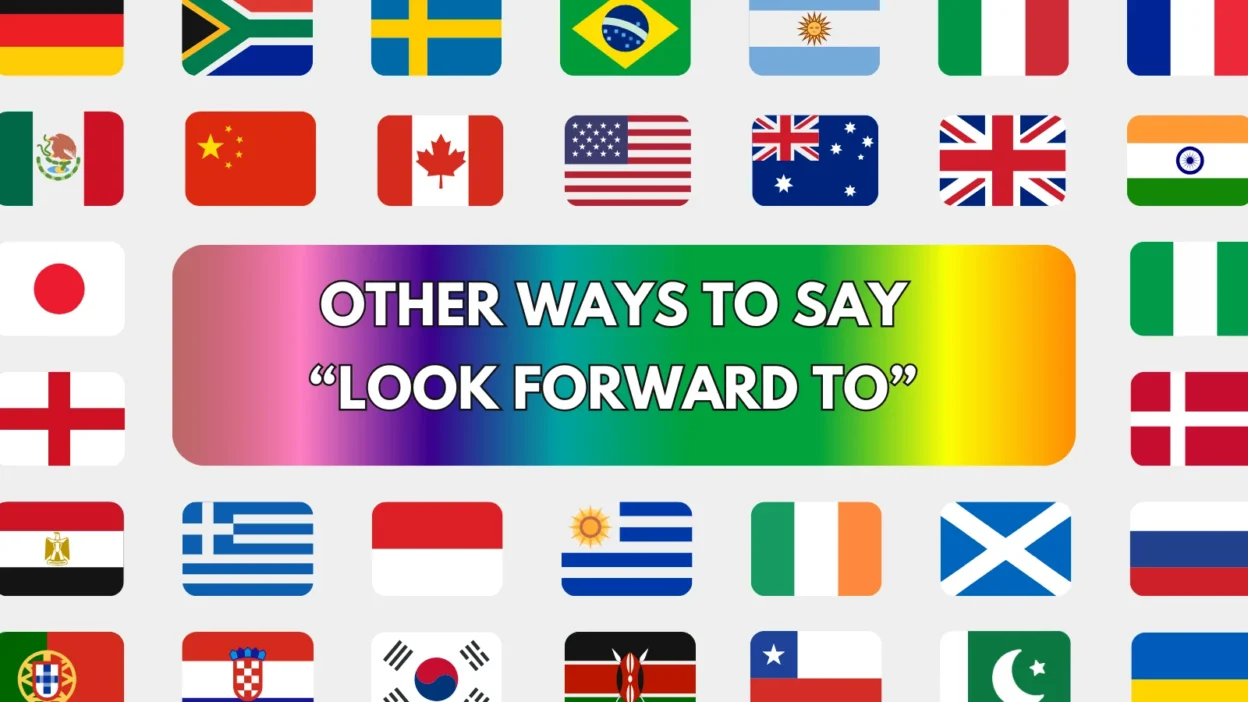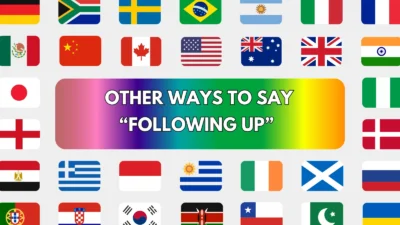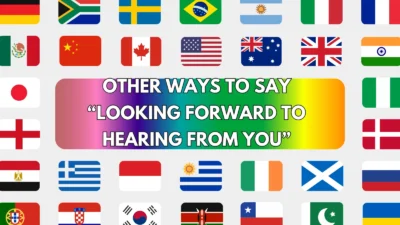The phrase “look forward to” is a common and professional way to express excitement or anticipation for a future event or communication. While polite and widely accepted, using it repeatedly can sound repetitive, especially in business or formal settings. Using different variations allows you to sound more personalized, enthusiastic, or professional depending on the occasion.
Here are 25 alternative ways to say “look forward to”, each tailored for different tones and scenarios.
1. Eager to
Meaning:
Shows strong enthusiasm or excitement about something upcoming.
Detailed Explanation:
Shorter and more direct than “look forward to,” often used informally.
Scenario Example:
I’m eager to begin our collaboration next week.
Best Use:
Casual emails, team messages.
Tone:
Friendly, enthusiastic.
2. Excited About
Meaning:
Conveys high anticipation and energy about something ahead.
Detailed Explanation:
Adds a personal, cheerful tone and works well for informal communication.
Scenario Example:
I’m really excited about our upcoming product launch.
Best Use:
Internal messages, informal updates.
Tone:
Lively, optimistic.
3. Anticipating
Meaning:
Shows you’re expecting something with interest.
Detailed Explanation:
More formal and intellectual than “excited,” suitable for written communication.
Scenario Example:
We are anticipating your feedback on the proposal.
Best Use:
Business emails, reports.
Tone:
Professional, thoughtful.
4. Can’t Wait To
Meaning:
Expresses intense excitement or impatience for something.
Detailed Explanation:
Informal and expressive, often used in friendly communication.
Scenario Example:
Can’t wait to catch up with you this weekend!
Best Use:
Casual conversations, social emails.
Tone:
Playful, enthusiastic.
5. Hope To
Meaning:
Shows a polite desire or expectation for something to happen.
Detailed Explanation:
Softer than “look forward to,” great when there’s some uncertainty involved.
Scenario Example:
I hope to continue working together on future projects.
Best Use:
Professional emails, polite communication.
Tone:
Humble, hopeful.
6. Keen To
Meaning:
Shows you’re very interested in something upcoming.
Detailed Explanation:
Common in British English, this version is both casual and polite.
Scenario Example:
I’m keen to explore partnership opportunities with your team.
Best Use:
Networking, international emails.
Tone:
Professional, respectful.
7. Counting Down the Days To
Meaning:
Conveys high excitement for something that will happen soon.
Detailed Explanation:
Adds strong personal emotion and eagerness.
Scenario Example:
I’m counting down the days to our annual retreat.
Best Use:
Personal messages, informal settings.
Tone:
Warm, enthusiastic.
8. Looking Ahead To
Meaning:
A forward-thinking way to express anticipation.
Detailed Explanation:
Great for professional or motivational communication.
Scenario Example:
We’re looking ahead to a productive quarter.
Best Use:
Reports, team emails.
Tone:
Optimistic, professional.
9. Awaiting
Meaning:
Formal word to say you’re waiting for something.
Detailed Explanation:
Best used in emails when expecting a reply or decision.
Scenario Example:
We are awaiting your final confirmation.
Best Use:
Business letters, formal emails.
Tone:
Formal, composed.
10. Hoping For
Meaning:
You are wishing or expecting something in the future.
Detailed Explanation:
Gentler and slightly more emotional than “look forward to.”
Scenario Example:
Hoping for another opportunity to work together soon.
Best Use:
Follow-up messages, polite requests.
Tone:
Kind, humble.
11. Excited to Connect
Meaning:
Enthusiastically looking forward to a meeting or relationship.
Detailed Explanation:
Warm and friendly, especially effective in networking.
Scenario Example:
I’m excited to connect during the conference next week.
Best Use:
LinkedIn messages, intros.
Tone:
Professional, inviting.
12. Enthusiastic About
Meaning:
You’re full of enthusiasm about a future event.
Detailed Explanation:
Adds energy while maintaining a professional tone.
Scenario Example:
We’re enthusiastic about the upcoming partnership.
Best Use:
Team updates, presentations.
Tone:
Upbeat, professional.
13. Ready For
Meaning:
Shows preparedness and anticipation.
Detailed Explanation:
Sounds confident and straightforward.
Scenario Example:
I’m ready for our meeting at 2 PM.
Best Use:
Internal communication, meeting prep.
Tone:
Confident, direct.
14. Can’t Wait to Work With You
Meaning:
A personal and informal way to express professional enthusiasm.
Detailed Explanation:
Adds warmth and approachability to your tone.
Scenario Example:
Can’t wait to work with you on this project!
Best Use:
Team emails, new introductions.
Tone:
Friendly, energetic.
15. I’ll Be Glad To
Meaning:
Expresses willingness and readiness to do something.
Detailed Explanation:
More humble and polite than eager expressions.
Scenario Example:
I’ll be glad to assist in any way I can.
Best Use:
Support emails, offers to help.
Tone:
Supportive, kind.
16. Anticipating Our Collaboration
Meaning:
Looking forward to working with someone.
Detailed Explanation:
Adds a formal and respectful tone to a professional relationship.
Scenario Example:
We’re anticipating our collaboration on this exciting campaign.
Best Use:
Business partnerships, project kickoffs.
Tone:
Professional, respectful.
17. Hoping to Hear From You Soon
Meaning:
Polite way of expecting a reply or response.
Detailed Explanation:
Less forceful than “looking forward to hearing,” soft and respectful.
Scenario Example:
Hoping to hear from you soon regarding the quote.
Best Use:
Follow-up emails, client communication.
Tone:
Polite, courteous.
18. I’m All Set For
Meaning:
You are prepared and ready for what’s next.
Detailed Explanation:
Sounds proactive and energetic, often used for meetings or tasks.
Scenario Example:
I’m all set for the kickoff call later today.
Best Use:
Internal coordination, briefings.
Tone:
Confident, upbeat.
19. We’re Planning For
Meaning:
Mentions something coming up that’s in preparation.
Detailed Explanation:
Practical and action-oriented, less emotional than “look forward to.”
Scenario Example:
We’re planning for next month’s campaign launch.
Best Use:
Team planning, project communication.
Tone:
Organized, informative.
20. Can’t Wait to See What’s Next
Meaning:
You’re excited and optimistic about future outcomes.
Detailed Explanation:
Adds positivity and momentum, often used in team settings.
Scenario Example:
Great job today — can’t wait to see what’s next!
Best Use:
Team motivation, post-project emails.
Tone:
Excited, optimistic.
21. Hope to Catch Up Soon
Meaning:
You’re looking forward to talking or meeting again.
Detailed Explanation:
Less formal and perfect for reconnecting with someone.
Scenario Example:
It’s been a while — hope to catch up soon!
Best Use:
Old colleagues, friends.
Tone:
Warm, casual.
22. We’re Looking Toward
Meaning:
A slightly formal way of expressing anticipation.
Detailed Explanation:
Often used in statements or press releases.
Scenario Example:
We’re looking toward a strong year ahead.
Best Use:
Corporate updates, announcements.
Tone:
Professional, forward-thinking.
23. Looking to Build a Great Relationship
Meaning:
You want to establish a strong future connection.
Detailed Explanation:
More personal and relationship-driven than “look forward to.”
Scenario Example:
Looking to build a great relationship with your organization.
Best Use:
Introductions, partnership emails.
Tone:
Friendly, respectful.
24. It’ll Be Great to Connect
Meaning:
Expresses excitement about an upcoming conversation.
Detailed Explanation:
Casual and inviting, great for soft openings.
Scenario Example:
It’ll be great to connect on Thursday.
Best Use:
Meeting confirmations, chats.
Tone:
Easygoing, open.
25. I’m Looking Forward With Excitement
Meaning:
Combines anticipation with strong emotion.
Detailed Explanation:
Emphasizes your emotional engagement about what’s coming.
Scenario Example:
I’m looking forward with excitement to what we’ll achieve together.
Best Use:
Motivational messages, team inspiration.
Tone:
Passionate, energetic.
Conclusion
While “look forward to” is a reliable phrase, having a range of alternatives allows you to sound more natural, flexible, and engaging. Whether you’re writing a formal email, sending a quick message, or building rapport, these 25 alternatives help you express your anticipation clearly and with the perfect tone.




